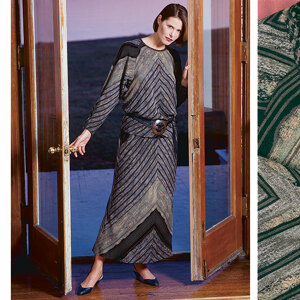
In “Teach Yourself to Sew: Bias basics,” Threads #172 (April/May 2014) Julianne Bramson, designer and co-owner of FashionInHarmony.com, explains what bias is, how to choose the right fabric and pattern for a bias-cut design, and tips for sewing and handling these garments. Here, we share more information about how and why bias-cut fabric acts differently from on-grain fabric, and how to weight the edge of a bias-cut garment before it’s hemmed.
How does the bias work?
A woven fabric’s true bias is at a 45-degree angle from the straight-of-grain, or selvage edge. In the diagram above, the bias is noted by the diagonal line, which delineates the spaces between the warp and weft threads in the fabric. When fabric is used at a 45-degree angle from the straight-of-grain, the threads (warp or weft) lose their inherent stability and transform around air spaces from square to diamond shapes, as shown below. When the fabric is pulled vertically, these diamonds are long and skinny. When the fabric is pulled horizontally, the diamond shapes become short and squat.
(When fabric is rotated to the true bias, and weight is applied, the collapse of air spaces enables a fabric square to morph into a diamond shape.)
How does this change in stability affect a bias-cut garment?
The malleability of woven fabric that is cut on the bias creates the magical effect of bias fit. The fabric is less stable and less able to retain its original dimensions when placed on the bias. Bias-cut garments that are not on a figure hang very long and narrow and appear to be designed for a very thin model. However, when they are placed over a three-dimensional form, the figure becomes the support for the fabric. The diamond-shaped spaces between threads expand and contract to conform to the curves of the body.
 |
 |
The same dress, top, on four different women demonstrates the effect of bias fit. Photo: James Keller Photo
What’s different about hemming a bias-cut garment?
Before you hem a bias-cut garment, it’s important to hang the garment long enough to allow the fabric to collapse fully. The hem will be uneven if you don’t allow gravity to have its effect. By adding weight to the bottom, you can speed up the process.
(In the image above, 15 to 20 medium-sized binder clips were clipped to the skirt’s hem.)
1. To begin, place the sewn garment on a dress form and add weight to the hem. Use binder clips, pin snap tape evenly around the hem, or fill a spray bottle with water and evenly spray 10 inches to 12 inches of the hem all around. If using a spray bottle, place a towel under the garment, and repeat several times once the garment is dry.
2. Leave the garment on the dress form for several days or up to a week.
3. Remove the clips or snap tape, and put the garment on the wearer’s body. Neatly mark the hem. Cut below this mark as follows: If you are only removing 1 inch to 2 inches, leave 1/2 inch of extra room. If you are removing 1 foot or more, leave at least 4 inches of extra space. The weight of removed fabric no longer pulls the garment down, so when cut, the garment raises up a bit. Check the hemline and remark if necessary.
Now that you know more about the bias, how do you feel about bias-cut garments? Have you made them before, and have you found that they fit particularly well? Do you have any tricks for working with fabric on the bias? Please share your comments below.
















































I had to alter the hem of a bias cut lining and underlining made of charmeuse two way stretch . The dress hung for week, after pinning to outer layers to get a circular finish once cut the linings no longer met the fullness of dress hem and I was devastated because it was too short on the fuller sides now, I dont understand how this was possible.
I'm not entirely sure I am correctly envisioning the situation in your particular garment, but I'm not surprised that the fabric stretched unpredictably. That's the beauty--and curse!--of bias-cut fabric. Looser weaves and lighter, shifty fabrics like charmeuse are the most difficult to control when they are cut on the bias. If the garment is quite full, and the actual bias grain is oriented in different directions on different parts (as in a circle or partial-circle skirt), you may have places where the hem ends up longer or shorter, even if you've weighted the hem equally all the way around.
Sometimes you can slightly reshape the garment with the iron, but over time, it will probably stretch vertically again. Cutting the lining a little shorter all around will at least hide it when the garment is worn.
I've seen a number of vintage and also contemporary, upscale garments with bias sections that are poorly controlled, so keep in mind that it's not just you! No one has totally solved the problem!
Carol Fresia, Threads Senior Technical Editor